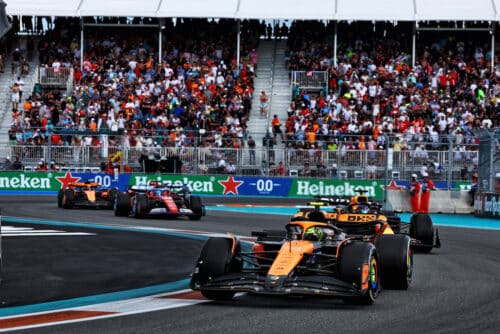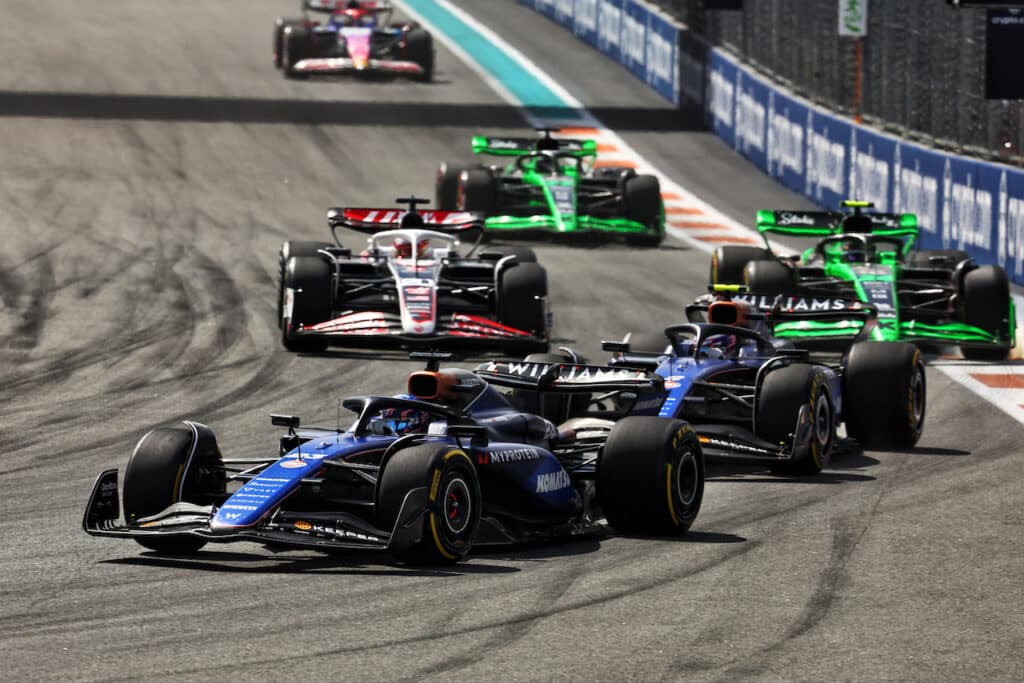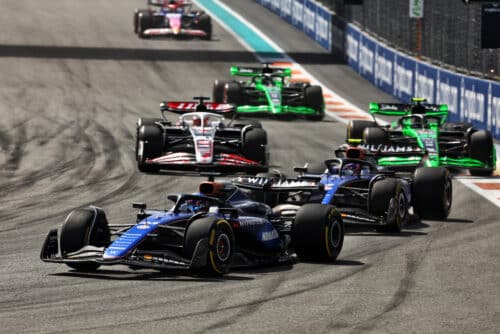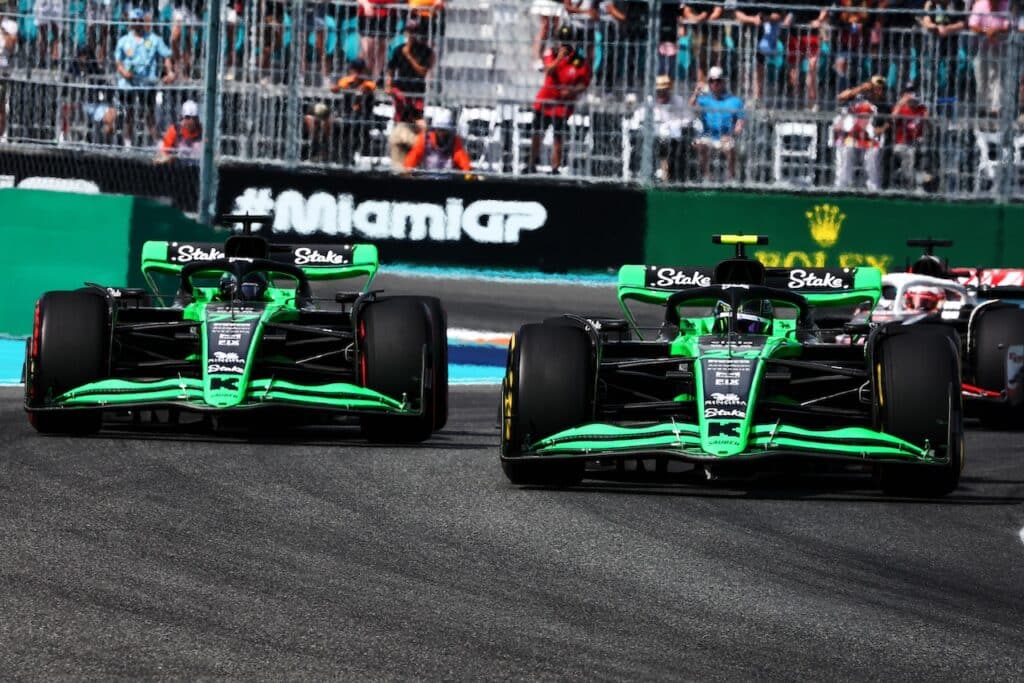F1 | United States Grand Prix: analysis of the race
Let's relive and analyze the most important moments of the US weekend
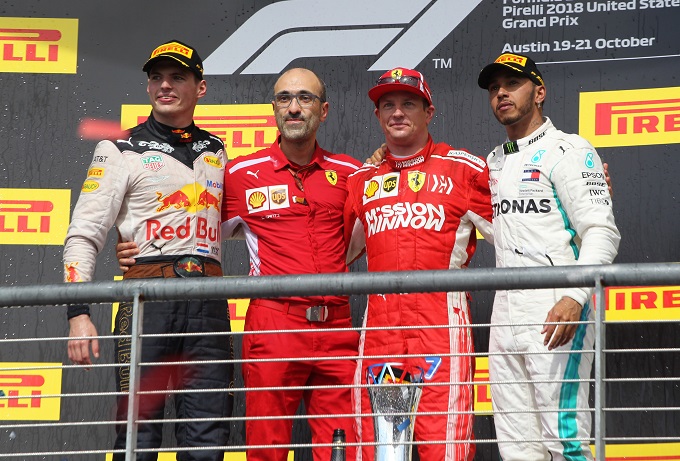
The fiftieth edition of the United States Grand Prix offered emotions, suspense and surprises, maintaining faith in an anniversary of such high importance for American motorsport. Kimi Raikkonen's winning ride sent millions of fans around the world into raptures, marking another important page in the history of this sport. There are many interesting insights to analyze that the US weekend provided us with, from the importance of strategy to Ferrari's newfound competitiveness, without forgetting the great comeback of Max Verstappen, who started eighteenth on the grid.
Kimi Raikkonen's victory
After 5 years and 113 Grands Prix, the Finn is finally back on the top step of the podium, achieving an expected, sought-after and deserved victory. A long fast to which the Ferrari driver finally put an end with a masterful performance, made up of intelligence and cunning.
It all started with a perfect start from the Finn, able to make the most of the advantage of the ultrasoft compound to overtake Lewis Hamilton and take the lead, exactly as in the most optimistic Ferrari forecasts. A planned and studied move by the Cavallino which had already decided on Saturday to diversify the strategy of its drivers, in order to shuffle the cards on the table: if with Sebastian Vettel they had remained on what could hypothetically be the best choice for the race, that is to qualify and start on supersoft rubber (like the two Mercedes and Daniel Ricciardo), for the Finn the Italian team had opted for a much more aggressive approach, using the ultrasoft compound, the softest made available by Pirelli for the American rendezvous. A choice that actually paid off, because having managed to take command of the race in the initial stages completely reversed the situation, forcing Hamilton to go from hare to hunter.
Analyzing the Finn's race, it undoubtedly stands out that his excellent tire management and his ability to resist Hamilton's attacks were the key to the race. In the first stint, after an exceptional start, Raikkonen was able to build that small gap of around 2 seconds useful for keeping his Mercedes rival at a safe distance and out of the DRS zone, an indispensable condition for thinking of being able to aim for final success.
Another decisive moment of the race was the entry of the Virtual Safety Car during the eleventh lap, a factor which posed the teams faced with the classic question: to stop, saving around ten seconds in the stop, but with the obligation of having to carry out a very long second stint of the race, or stay on the track and follow the planned strategy? If on many occasions the Ferrari pit wall has been harshly criticized for having made the wrong decision or for having made gross errors, in this case we must congratulate him, because the vision of the race by the Ferrari engineers was absolutely perfect. As tempting as the opportunity to save about ten seconds by stopping under VSC was, it should be underlined that there were also several disadvantages in making this decision. According to the simulations and calculations of the Maranello team, anticipating the stop already on the eleventh lap would have entailed the need to stop again late in the race, with the risk of finding oneself in traffic and missing the train useful for fighting for the victory in the final laps . Secondly, it was not to be overlooked that at that moment Raikkonen was not only racing against Hamilton, but also against Valtteri Bottas, who was about six seconds behind the leading duo. If the Ferrari driver had pitted under the Virtual Safety Car, he would clearly have saved around ten seconds during the stop, but he would then have run the risk of falling into the trap that Mercedes has already used several times during this season, namely using Bottas as block. Putting ourselves in the Mercedes perspective, this would have been the ideal situation for the Anglo-German team: Hamilton would have been able to extend the first stint on the supersofts without being particularly penalised, while Raikkonen would not only have run the risk of losing the advantage gained thanks to the pit stop under VSC behind Bottas, but he could also have ended up in a situation that would ruin his tires very quickly, so much so that he was forced to bring forward a possible second stop. Scuderia Ferrari is therefore due praise for making the right choice, without giving up the advantage of track position.
The rest is a Kimi Raikkonen masterpiece. A test of great mastery, where all his talent was seen, of a driver who at 39 years old still knows how to be a point of reference for the entire grid. Very skilled in tire management - both the ultrasoft in the laps before the stop and the soft in the second stint - and with the heart of a lion in the duel against Hamilton, without fear, without fear, but always correct. It was vital to keep the Englishman behind, making him lose as much time as possible before the stop, without however risking an undercut from Bottas, only a few seconds behind him. In this situation both the 2007 world champion and the wall were perfect and the satisfaction shown by Carlo Santi, the Finn's track engineer, is proof of this. Raikkonen managed to put together a perfect race, almost a sweet symphony not only for the Ferrari fans, but also for the millions of fans who support and admire him. A victory hoped for and dreamed of by many. Ode to you, Kimi.
3 riders on the podium, 3 different strategies
The United States Grand Prix was a Grand Prix in which strategy choices had a fundamental role in the progress of the race, much more than in other world championship events. Friday's rain mixed the cards, forcing the teams to take to the track for qualifying and the race in almost darkness, without the classic references and data that teams usually obtain during free practice. Crucial data for achieving the optimal set-up and for preparing strategies for the race. With only one dry session available before qualifying, in FP3 the teams had chosen to concentrate on using the softest compounds available for the simulation of the flying lap and the first part of the race, leaving aside the soft, the tire which then it proved decisive on Sunday. It should therefore not be surprising that the top 3 finishers reached the finish line following 3 completely different strategies. This shows how the show can often arrive in the most unexpected and unexpected way, offering variety and interesting insights.
Where did Mercedes go wrong?
If the Ferrari wall played its cards to perfection last Sunday, the same certainly cannot be said for the Mercedes wall, guilty of having compressed a result that would have allowed Lewis Hamilton to close the world championship already in Austin. But what exactly did the little wall do wrong?Silver arrows"?
The strategy planned by the Anglo-German team for Hamilton completely followed what was the option recommended by Pirelli, i.e. an initial part of the race of around 22 laps on supersoft tyre, to then mount the soft and go to the finish line. For the Englishman everything became complicated when Raikkonen managed to overtake him at the start, forcing him to switch from a management race to an attack one. The first opportunity to try to reverse the fate of the race presented itself a few laps later with the entry of the Virtual Safety Car: if this time Ferrari did not give in to the temptation to stop while maintaining track position, Mercedes chose the opposite approach, anticipating the pit stop to recover those ten seconds which in the economy of a single stop race could have actually made the difference. From their Stuttgart manufacturer's point of view, this could also have been a strategy that could bear fruit, as long as they were sure they could complete the remaining 45 laps without the need to stop again. Hamilton would have managed to quickly get back behind Raikkonen - thanks also to the long-term drop in performance of the ultrasoft -, guaranteeing himself a good lead after the Finnish driver's stop. The Bottas factor should also not be overlooked, as it could have been useful to the cause if it had been needed. Net of the final result, it is difficult to speak of a completely incorrect wrong choice, because if at that moment at the wall they were sure of being able to finish the race without a second stop, the chances of being able to obtain the final success were actually quite high. Mercedes' real mistake occurred about twenty laps later, when the soft tire mounted under VSC began to show the first signs of fatigue, with the times continuing to rise. Most likely at the pit wall they were caught off guard by such anomalous wear, not expecting such a sudden drop in tire wear after just over 20 laps, about half of those they would have had to complete to think of finishing the race with a single stop.
Undoubtedly at that moment the objective was to extend the life of the tire as much as possible, in order to see how many concrete possibilities there were of reaching the end without the need to stop again, without neglecting the opportunity to fit a more aggressive compound. in the event of a particularly short third stint. On the other hand, however, at that moment there was also a need for a quick decision, not only because Raikkonen was starting to gain significantly, but also because Verstappen was gradually moving into Hamilton's pit window: vi it was the risk not only of sending Lewis back onto the track in traffic, but also of putting him behind a tough guy like the Dutchman, someone who never moves back an inch.
Mercedes was not particularly reactive from this point of view, leaving its top driver out for those 4/5 laps which then allowed not only Raikkonen to regain the lead of the race with a certain advantage, but also Verstappen to be able to grab second position, putting the "Silver Arrows" driver behind him. A serious lack of attention on the wall which further complicated the Englishman's race, who saw the opportunity to win the world championship already taken away from him on American soil. After finding himself in third position, Hamilton rightly chose a very conservative approach, without daring and without putting too much risk on a podium that brings him ever closer to winning the title. Once the first match point fails, Lewis will be able to return to Mexico, where he will only need to gain five points over Sebastian Vettel to become world champion for the fifth time.
Verstappen's comeback
Starting eighteenth and finishing in second place just under a second behind the winner is not everyone's job and if there was a driver who could achieve this feat it was Max Verstappen. Forced to start from the last rows of the grid following the failure of the rear suspension during qualifying, the young Dutchman immediately put on his usual show of overtaking and consistency, so much so that he was able to climb back up to fifth place in just seven seconds. race laps. True, driving a car like the RB14 helps, but the ease with which the Red Bull driver manages to turn the situation around in such a short time is disarming every time, almost hard to believe, as if the other drivers were simple pins to overcome. Flashes of pure talent from a driver who is probably starting to find his right dimension to be able to express himself at his best. The Red Bull wall also gave him a hand, guaranteeing him what probably turned out to be the best strategy of the race, although obviously it's always up to the driver to make the most of it, as Max did on this occasion.
Verstappen built his second place finish in two crucial phases of the race. The first between 14th and 21st, where he was able to impose an extraordinary pace, second only to that of Sebastian Vettel, but enough to reduce the gap from the top from 12 to 4 seconds, also taking advantage of the drop in performance of Raikkonen's ultrasoft . The second in the final laps of the race, where he skilfully resisted Hamilton's attacks. On Sunday the young Dutchman proved to be fast, consistent and concrete, as he has so many times this season. The objective must be to continue on this path, hoping that the Red Bull-Honda combination can provide him with a car capable of fighting for more prestigious results.
Ferrari's newfound competitiveness
After some difficult Grands Prix, in Austin Ferrari finally returned to the levels of competitiveness to which it had accustomed us for most of the season. A truly positive weekend for the Red, except for the difficulties encountered in the wet during free practice, in which the SF71H did not feel at ease despite the long time spent on the track looking for the ideal set-up. However, Friday was not a waste of time, because the Maranello team was able to collect a lot of data, which will then be analyzed at the factory to try to solve the SF71H's chronic adaptation problems on water.
This newfound competitiveness comes from several factors. First of all, the decision (taken already after Friday in Suzuka) to take a step back in terms of updates, both aerodynamic and mechanical, giving up part of the latest developments introduced in previous races, was fundamental. It is important to underline that this does not only have repercussions on the updates themselves, but also on the setting of the car and the settings chosen. A small technical crisis which mainly concerned the rear end of the car, which was too loose and difficult to manage. If in Singapore one could assume that it had just been an unlucky weekend from a set-up point of view, in Russia it had become clear that the lack of grip at the rear was the cause of a good part of the problems that were afflicting the Prancing Horse car. Difficulties that became particularly evident in the third sector of the Russian circuit, the one in which having a stable and high-performance rear end is essential to make the most of the traction areas, an aspect in which Ferrari is always among the best, if not the queen of the category during 2018.
However, there are also other factors that have negatively influenced the performance of the Rossa, regarding the exploitation of the Power Unit. In the last 3 events before the US GP, there had been a lot of talk about an SF71H running out of engine in certain phases of the weekend, not at its full potential. This lack of performance was then confirmed by GPS data, which demonstrated that Ferrari no longer had that sort of extra boost on the straights that often made the difference in qualifying or in some moments of the race. This does not mean that Ferrari no longer earned on long stretches, but only that it was not able to be as incisive as in the pre-Singapore events. There have long been rumors about what the reasons for this sudden drop in power could be. There are those who hypothesized that it was for reliability reasons, in order to be able to reach the end of the season without the need to incur penalties for the use of a fourth unit, those who thought that it could be linked to a request from the FIA (later denied) and who believed that everything could be linked to the recent difficulties encountered at both an aerodynamic and mechanical level, so as not to further stress the tyres. Undoubtedly it is a lack that was felt in the overall economy of the package, but at the same time it is clear that this was not the only reason (nor even the main one) for the poor performance of the SF71H.
A situation that seems to have reversed in Austin, where the Red car would finally return to the power levels seen at Spa and Monza. A sensation not only confirmed by the GPS data, but also by some particularly interesting details regarding the use of some modes of the Power Unit. At Ferrari the most aggressive mappings for the exploitation of the hybrid are called "K1" and "K2". At the American event, a new mapping called "K1 Plus" made its debut, tested several times during free practice, which would have helped bring the SF71H back to pre-Singapore power levels. Another detail that emerged last weekend concerns the use of the K2 mapping: in general this could almost be seen as a "push to pass", a sort of extraboost that can be activated with a button on the steering wheel which guarantees a momentary increase in power to be used in qualification, at the start or during the overtaking phases. In particular, in the early stages of the race the K2 is used together with the “Engine 1” mode (the most aggressive endothermic side mapping) for the entire first lap, providing those additional horses that often helped Sebastian Vettel to make the gap after the departure. So far everything is normal, if it weren't for the fact that in the events in Singapore, Russia and Sochi the K2 was used differently, limiting its use in the initial phases to only about half a lap. Another noteworthy aspect concerns the management of the internal combustion engine. As explained previously, in the starting phases Ferrari usually uses very aggressive mappings not only for the electrical part, but also for the ICE, internally called "Engine 1". Typically, once the K2 is deactivated, the Maranello team maintains the "Engine 1" mode for a few more laps before moving on to more conservative mappings such as "Engine 3" and "Engine 4", in order to build a small advantage over the rivals which guarantees him the possibility of being able to manage tires and fuel in the subsequent stages of the race, or which in any case allows him to put pressure on the drivers who precede the two Cavallino standard-bearers. In the 3 offending Grands Prix, however, a different situation arose, in which the Red team had decreased the use of the more aggressive mappings both regarding the hybrid (K2 only for less than one lap) and the endothermic, asking the drivers to switch to more conservative modes already on the second lap (switching from Engine 1 to Engine 3). In Austin the situation seemed to return to normal already in free practice, where both drivers were able to rely for longer on the more aggressive mappings even in the classic starting tests. It will be interesting to follow the story to understand whether in the next rounds of the world championship the situation will be similar to that which occurred in the United States Grand Prix.
Ferrari's newfound competitiveness is confirmed not only by the final success or the excellent tire management, but also by the comparison in qualifying with Mercedes. As can be seen from the graph above which compares the two laps in Q3 by Sebastian Vettel and Lewis Hamilton, the SF71H once again made the difference in the traction sections and on the straights, defending itself admirably even on the long bends, as has always happened during this season. Work still remains to be done on those sectors where Mercedes' rivals make the difference, particularly in those phases where the stability and precision of the front allows you to force braking or bring greater speed into corners, as in the fast sequence from curve 5 to 9, very similar to the much better known one Maggots, Becketts and Chapel of Silverstone. For Ferrari, net of the final results, it was vital to find itself again and have confirmation of what had not worked in the previous events. The US weekend seems to have brought the Red Team back on the right track.
if you want to always be updated on our news
Follow us here




![F1 | Verstappen "upset" after seeing Perez's departure in Miami [VIDEO]](https://f1grandprix.motorionline.com/wp-content/uploads/2024/05/f1-verstappen-partenza-gp-miami-1024x555.jpg)
![F1 | Verstappen "upset" after seeing Perez's departure in Miami [VIDEO]](https://f1grandprix.motorionline.com/wp-content/uploads/2024/05/f1-verstappen-partenza-gp-miami-500x271.jpg)
![F1 | GP Miami, SC changes the balance of the race between Verstappen and Norris: Ivan Capelli's analysis [VIDEO]](https://f1grandprix.motorionline.com/wp-content/uploads/2024/05/f1-gp-miami-norris-mclaren-1024x551.jpg)
![F1 | GP Miami, SC changes the balance of the race between Verstappen and Norris: Ivan Capelli's analysis [VIDEO]](https://f1grandprix.motorionline.com/wp-content/uploads/2024/05/f1-gp-miami-norris-mclaren-500x269.jpg)
![F1 | Ferrari shone in Miami even without updates, optimism grows ahead of Imola [VIDEO]](https://f1grandprix.motorionline.com/wp-content/uploads/2024/05/f1-gp-miami-ferrari-1024x550.jpg)
![F1 | Ferrari shone in Miami even without updates, optimism grows ahead of Imola [VIDEO]](https://f1grandprix.motorionline.com/wp-content/uploads/2024/05/f1-gp-miami-ferrari-500x268.jpg)
![Formula 1 | Norris, the reward for his trust in McLaren arrives in Miami [VIDEO]](https://f1grandprix.motorionline.com/wp-content/uploads/2024/05/mclaren-norris-gp-miami-1024x549.jpg)
![Formula 1 | Norris, the reward for his trust in McLaren arrives in Miami [VIDEO]](https://f1grandprix.motorionline.com/wp-content/uploads/2024/05/mclaren-norris-gp-miami-500x268.jpg)
![F1 | McLaren from ugly duckling to swan: the evolution that led the MCL38 to victory [VIDEO]](https://f1grandprix.motorionline.com/wp-content/uploads/2024/05/f1-mclaren-gp-miami-1024x551.jpg)
![F1 | McLaren from ugly duckling to swan: the evolution that led the MCL38 to victory [VIDEO]](https://f1grandprix.motorionline.com/wp-content/uploads/2024/05/f1-mclaren-gp-miami-500x269.jpg)

